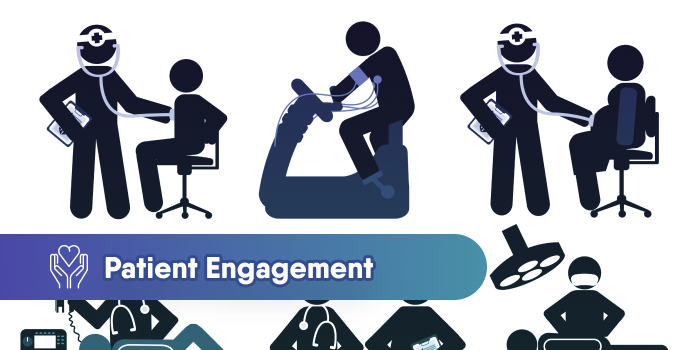Everything You Need to Know About Patient Engagement and HIPAA Compliance
Patient engagement and HIPAA compliance are key elements to cultivate trust and security among healthcare providers and patients. Find out how you...
5 min read
Paul Dumayac : 4/12/22 7:00 AM

Relevant patient education, effective patient and office communication, constant monitoring and response to feedback, patient-family engagement, and staff training offer ways to increase your patient engagement and improve health outcomes.
Medical practices implement patient-centered strategies, such as patient engagement, to increase the active participation of patients in their healthcare management. As a result, health outcomes improve.
There are five key ways that patient engagement improves health outcomes, but first, let’s uncover what patient engagement activities are.
Patient engagement activities establish the necessary connection to develop a lasting collaborative patient-provider relationship.
Examples of patient engagement activities include, but are not limited to:
As you can see, there are many ways to engage with patients and establish a strong patient-provider relationship. And now, here are the five ways patient engagement activities improve patient outcomes.
To achieve improved health outcomes, it is necessary for your medical practice to find ways to increase patient engagement. Here are five methods:
Patient education is an essential aspect of patient engagement. It is the most effective way of nurturing positive results for patients. Patient engagement via education enables your patient to acquire a grasp of their health condition.
Patient education encourages patients to be more cooperative in managing their health conditions, increasing their commitment to the care plan. When patients cooperate in complying with prescribed medication and treatments, healthcare becomes more efficient and cost-effective. It also allows continuity of care and decreases the likelihood of illness complications.
Telemedicine is an opportunity for your practice to engage your patients in health education. Virtual visits or consultations do not limit you to educating patients about health. Instead, it offers more possibilities for you to be creative and effective in patient education by allowing you to use relevant audio, video, and other educational aids.
Patient communication is a patient engagement strategy medical practices implement that enhances the outcome of healthcare delivery.
By ensuring that you regularly talk to your patients you keep yourself on top of your patient management. Patient communication results in positive outcomes, such as increased patient satisfaction and effective intervention when a medical need arises. When healthcare providers (HCPs) implement communication protocols that facilitate efficient communication between patients and staff, the quality of care improves.
Scheduled communications, like automated appointment or treatment reminder messaging, enable your office to reduce patient no-shows and improve care. HIPAA-compliant 2-way texting is a secure and straightforward way of implementing booking options and appointment reminder protocols to communicate with your patients, which benefits them and your front office.
When executed efficiently, communication encourages collaboration from patients, fosters teamwork between you and the patient, and helps prevent staff errors.
Therefore, it is indispensable for providers and their staff to have good communication skills with patients.
Monitoring patient feedback gives you a better view of how your patients feel and think about their experience with your practice. Responding to feedback allows you to gather more information and have the power to improve your practice and patient outcomes.
You must see to it, then, that your medical practice implements a system that collects patient feedback and reviews, such as Curogram’s automated surveys and rating requests feature. They are essential sources of information that help you enforce changes to improve office efficiency and care quality. With Curogram, your practice can send patients automatic one-line text surveys immediately after their appointment with you. Their response helps you identify if they are happy with your service so you can share positive reviews online. The survey likewise identifies unhappy patients, and you can get valuable information about which aspects of your practice need improvement.
With the proper consent of patients, having their family and friends during office consultations and on virtual consultations doesn't just buy you more credit for being a patient-friendly provider. It allows your patient’s support system to help you increase patient cooperation and improve health outcomes. According to the U.S. Department of Health and Human Services Agency for Healthcare Research and Quality (AHRQ), these outcomes are achievable with the help of the strategies laid out in a guide they released.
Patient and family involvement in decision-making presents opportunities for more patient-centric healthcare and can prove essential for optimal health outcomes in certain cases. It produces outcomes such as reduced pain and discomfort and a faster recovery rate both physically and emotionally because of the support the family or friends provide.
Continuing education and regular training for medical staff and workers not only provides an opportunity to evaluate the abilities and skills of your employees but also helps to improve their overall performance while carrying out their responsibilities at work.
A trained staff equips your medical practice to perform efficient patient engagement activities such as patient education, patient and office communication, feedback and review monitoring, and patient family and friends engagements.
Its other beneficial effects include boosting the morale of your staff, high staff retention, and efficient workflow.
Health outcomes gauge changes in a patient's health condition resulting from measures or specific healthcare investments or interventions, including patient engagement efforts.
Health outcomes include:
Patient-reported outcomes are vital in improving clinical care because they improve the connection between doctors and patients.
When HCPs measure and report outcomes, they promote improvements and best practices. Understanding outcomes and doing something about them is critical in providing value in healthcare.
Improving patient outcomes should be the ultimate goal for patient care in all aspects, as healthcare outcomes are accurate measures of quality. As in businesses, it is wise to always measure quality from the customer's perspective and not from the supplier's point of view only. In other words, healthcare should not center on your medical practice but your patients.
For example, HCPs measure patient outcomes by a medical condition, such as asthma, arthritis, diabetes, or Parkinson's, and the improvements their patients experience after undergoing treatment. They do not measure it by their specialty field, such as internal medicine, nor by interventions, such as minor surgery or monitored medication. Furthermore, outcome measurement ought to cover the entire cycle of care for the condition and follow‐up care.
These outcomes, however, are a result of provider-centered care, and therefore non-collaborative with patients. They are either limited, restricted, or are less effective without integrating patient engagement strategies. For example, engaging patients by showing an image of their wound, a progress chart of their healing, and an infographic illustration of the care plan would motivate them to cooperate and work more closely with clinicians, caregivers, or family members to recuperate faster.
Another example would be engaging patients living with asthma. After visiting, undergoing lung function tests, and receiving prescriptions to keep their airways open and prevent future attacks, you make sure their medication is working and they are breathing normally. You then ask asthma patients if they have any questions about their medication or experience any side effects. You further engage with them by sending a message when it's time to have a follow-up appointment and texting them a reminder.
Engaging patients with chronic health conditions, meanwhile, involve showing them their routine laboratory results to show that their medication is working and keeping their conditions manageable, and comparing these to episodes when they missed or refuse to follow their prescribed medications. Engage with them further by asking them how they feel and if they have complaints of side effects about the medicines or other symptoms.
These patient engagement strategies are either done in person or over a virtual visit via telemedicine.
Undoubtedly, increased patient engagement improves health outcomes. To achieve this requires you to implement patient education, expand communication methods, monitor and respond to feedback, employ patient-family cooperation when necessary, and continually train staff.
There can be more than the five ways presented above to increase patient engagement. What is important is that you aim to be patient-centric in your approach. Employing third-party technologies like Curogram that are secure and have HIPAA-compliant text messaging allows you to achieve some of the engagements for positive outcomes.

Patient engagement and HIPAA compliance are key elements to cultivate trust and security among healthcare providers and patients. Find out how you...

Patient engagement has increasingly become more critical in every healthcare organization, from hospitals to small medical practices. So, how will...

Happy patients make for a healthy medical practice. The key to success is delivering what is most important to the people who are entrusting you with...